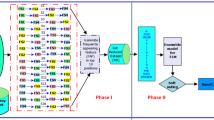Abstract
Multi-class imbalance is one of the challenging problems in many real-world applications, from medical diagnosis to intrusion detection, etc. Existing methods for gene expression classification usually assume relatively balanced class distribution. However, the assumption is invalid for imbalanced data learning. This paper presents an effective method named EN-FWELM for class imbalance learning. First, based on a fast classifier extreme learning machine (ELM), fuzzy membership of sample is proposed in order to eliminate classification error coming from noise and outlier samples, and balance factor is introduced in combination with sample distribution and sample number associated with class to alleviate the bias against performance caused by imbalanced data. Furthermore, ensemble of ELMs is used for making classification performance more stable and accurate. A number of base ELMs are removed based on dissimilarity measure, and the remaining base ELMs are integrated by majority voting. Finally, experimental results on various gene expression classification and real-world classification demonstrate that the proposed EN-FWELM remarkably outperforms other approaches in the literature.



Similar content being viewed by others
Explore related subjects
Discover the latest articles, news and stories from top researchers in related subjects.References
Liu JJ, Cai WS, Shao XG (2011) Cancer classification based on microarray gene expression data using a principal component accumulation method. Sci China Chem 54(5):802–811
Kar S, Sharma KD, Maitra M (2015) Gene selection from microarray gene expression data for classification of cancer subgroups employing PSO and adaptive K-nearest neighborhood technique. Expert Syst Appl 42(1):612–627
Yu HL, Hong SF, Yang XB (2013) Recognition of multiple imbalanced cancer types based on DNA microarray data using ensemble classifiers. BioMed Res Int 2013:1–13
Zainuddin Z, Ong P (2011) Reliable multiclass cancer classification of microarray gene expression profiles using an improved wavelet neural network. Expert Syst Appl 38(11):13711–13722
Huang GB, Zhu QY, Siew CK (2006) Extreme learning machine: theory and applications. Neurocomputing 70(1):489–501
Cao JW, Lin ZP, Huang GB (2012) Self-adaptive evolutionary extreme learning machine. Neural Process Lett 36(3):285–305
Huang GB, Ding X, Zhou H (2010) Optimization method based extreme learning machine for classification. Neurocomputing 74(1):155–163
Ding SF, Xu XZ, Nie R (2014) Extreme learning machine and its applications. Neural Comput Appl 25:549–556
Mohammed AA, Minhas R, Wu QMJ, Sid-Ahmed MA (2012) Human face recognition based on multidimensional pca and extreme learning machine. Pattern Recognit 44(10):2588–2597
Kaya Y, Uyar M (2013) A hybrid decision support system based on rough set and extreme learning machine for diagnosis of hepatitis disease. Appl Soft Comput 13(8):3429–3438
Li LN et al (2012) A computer aided diagnosis system for thyroid disease using extreme learning machine. J Med Syst 36(5):3327–3337
Hu L et al (2015) An efficient machine learning approach for diagnosis of paraquat-poisoned patients. Comput Biol Med 59:116–124
Lan Y, Soh YC, Huang GB (2009) Ensemble of online sequential extreme learning machine. Neurocomputing 72(13):3391–3395
Shigei N, Miyajima H, Maeda M et al (2009) Bagging and AdaBoost algorithms for vector quantization. Neurocomputing 73(1):106–114
Cao JW, Lin ZP, Huang GB, Liu N (2012) Voting based extreme learning machine. Inf Sci 185(1):66–77
Li K, Kong X, Lu Z, Liu W, Yin J (2014) Boosting weighted ELM for imbalanced learning. Neurocomputing 128:15–21
Zhang Y, Liu B, Cai J, Zhang SH (2016) Ensemble weighted extreme learning machine for imbalanced data classification based on differential evolution. Neural Comput Appl 28(1):1–9
Xu Y, Wang QW, Wei ZY (2017) Traffic sign recognition algorithm combining weighted ELM and AdaBoost. JCCS 38(9):2028–2032
Lu HJ, An CL, Zheng EH, Lu Y (2014) Dissimilarity based ensemble of extreme learning machine for gene expression data classification. Neurocomputing 128:22–30
Zong WW, Huang GB, Chen YQ (2013) Weighted extreme learning machine for imbalance learning. Neurocomputing 101(3):229–242
Zhang WB, Ji HB (2013) Fuzzy extreme learning machine for classification. Electron Lett 49(7):448–449
He H, Garcia EA (2009) Learning from imbalanced data. IEEE Trans Knowl Data Eng 21(9):1263–1284
Chawla NV, Bowyer KW, Hall LO, Kegelmeyer WP (2002) SMOTE: synthetic minority over-sampling technique. J Artif Intell Res 16(1):321–357
Liu XY, Wu J, Zhou ZH (2009) Exploratory undersampling for class-imbalance learning. IEEE Trans Syst Man Cybern Part B 39(2):539–550
Zhou ZH, Liu XY (2006) Training cost-sensitive neural networks with methods addressing the class imbalance problem. IEEE Trans Knowl Data Eng 18(1):63–77
Bartlett PL (1998) The sample complexity of pattern classification with neural networks: the size of the weights is more important than the size of the network. IEEE Trans Inf Theory 44(2):525–536
Lin CF, Wang SD (2002) Fuzzy support vector machines. IEEE Trans Neural Netw 13(2):464–471
Lin SJ, Chang C, Hsu MF (2013) Multiple extreme learning machines for a two-class imbalance corporate life cycle prediction. Knowl-Based Syst 39(3):214–223
KEEL repository. http://sci2s.ugr.es/keel/imbalanced.php
Cover TM, Thomas JA (1991) Elements of information theory. Wiley, New York
Author information
Authors and Affiliations
Corresponding author
Rights and permissions
About this article
Cite this article
Wang, Y., Wang, A., Ai, Q. et al. Ensemble based fuzzy weighted extreme learning machine for gene expression classification. Appl Intell 49, 1161–1171 (2019). https://doi.org/10.1007/s10489-018-1322-z
Published:
Issue Date:
DOI: https://doi.org/10.1007/s10489-018-1322-z




